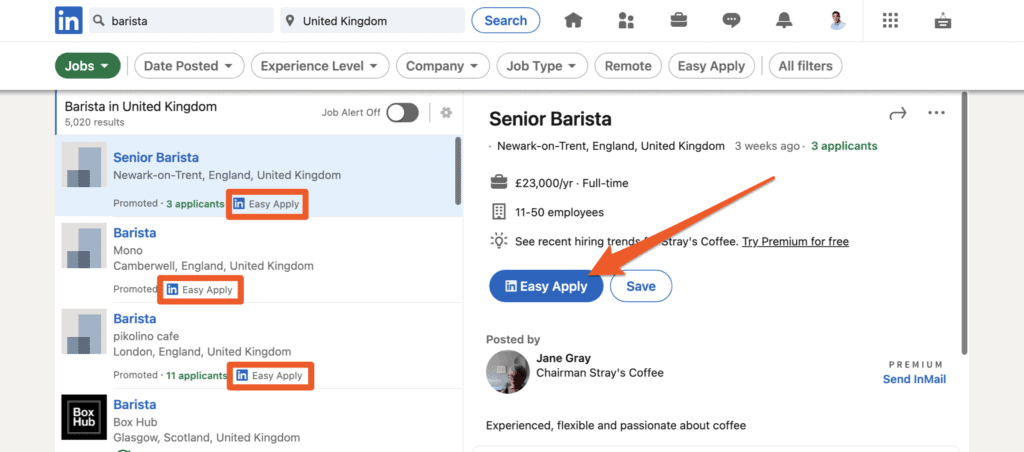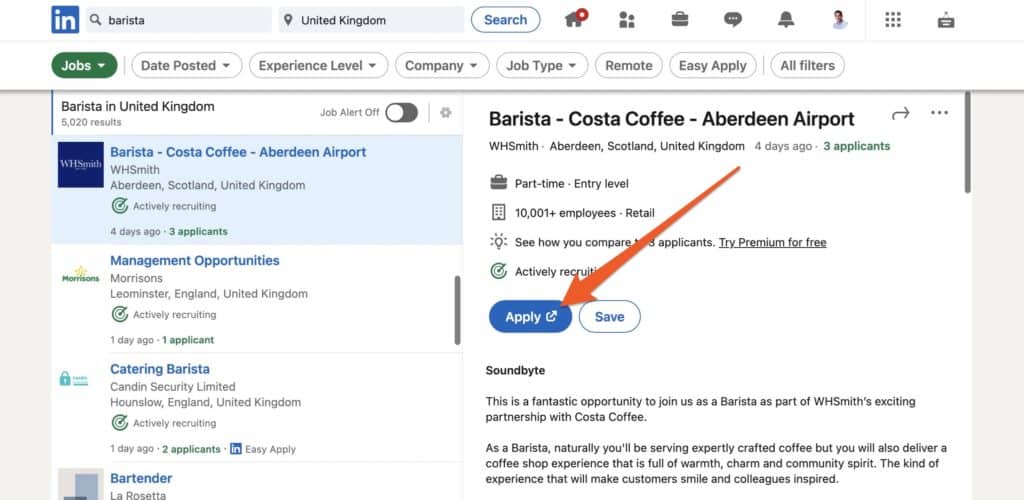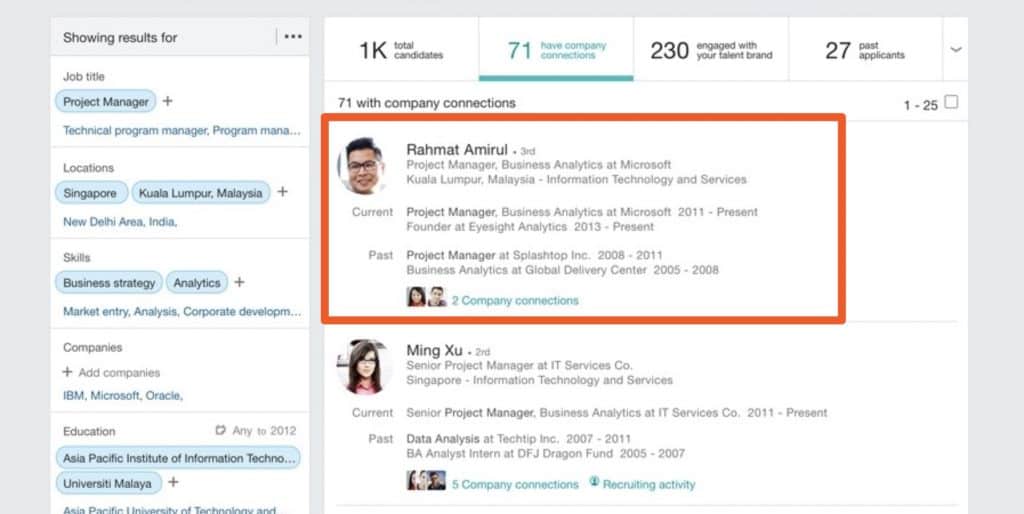Job searching is a numbers game. It all comes down to how many jobs you apply for, and how many applications a company receives.
But when each application involves submitting your resume and writing a cover letter, this process becomes tedious without resorting to the Easy Apply button on LinkedIn.
In this article, we’ll delve into exactly what Linked Easy Apply is, when and how you should use it, and how to make your applications stand out.
What is LinkedIn Easy Apply?
Linkedin Easy Apply was launched in 2011, designed to help make job applications simpler for applicants while increasing application volume for companies looking to hire.
It works exactly as the name suggests. When companies enable it, job seekers will see a one-click button on LinkedIn that allows them to start the application process without leaving the platform.
Here’s an example of a job with LinkedIn Easy apply enabled:

After clicking on the blue Easy Apply button, you’ll be prompted to enter your contact details, some of which LinkedIn conveniently fills in for you. (That’s where the “easy” comes in.)
You can also attach your resume and review everything before submitting your application to the relevant recruiter or employer, who then automatically gains access to your LinkedIn profile.
When Should You Apply to Jobs Using LinkedIn Easy Apply?
LinkedIn Easy Apply is a great way to expedite job applications and is one of the many reasons LinkedIn is so popular for finding jobs.
As with all time-saving devices, however, you risk compromising the quality of your applications if used incorrectly.
For example, using LinkedIn Easy Apply means:
- Your application is less informative, making your first impression weaker.
- It doesn’t describe your value or highlight your potential to the recruiter or potential employer.
- Other applicants use it too, and the sheer number of them means your application may end up buried.
However, there are times when Easy Apply is a valid means of applying.
Let’s cover them in more detail.
1. Your LinkedIn Profile is Rock Solid
The first thing an employer will see from an Easy Apply application is your LinkedIn profile, even if you attached your resume.
With that in mind, a well-optimized LinkedIn profile can compensate for the drawbacks of using Easy Apply, particularly if it includes:
- A photo that’s both professional and friendly.
- A strong and impactful headline rich in industry-specific keywords and phrases.
- Work experience that demonstrates your value to the recruiter, reinforced by good recommendations made by authoritative people in your network.
- Personal details such as hobbies, passions, or charitable causes you support.
2. The Opportunity Perfectly Matches Your Profile
There will be times in your job search when you come across a position seemingly tailor-made to your skillset.
In those cases, your LinkedIn profile is probably well-matched to the position by default and doesn’t require any further justification.
Basically, if you’ve put a lot of work into your profile, it aptly describes your professional value and abilities, and it matches the role being advertised, we suggest using Easy Apply.
3. You Don’t Have Enough Time to Respond
Timing is key when applying for jobs, and there are two time-sensitive examples where Easy Apply is appropriate.
The first is when the job application has a deadline. A missed deadline is almost always a missed opportunity.
The second is when your work and personal responsibilities are overwhelming, and you don’t have time to spend on a lengthy application.
In such cases, using Easy Apply can be the difference between applying or missing out altogether. While a limited application isn’t ideal, it’s better than no application at all.
4. You Aren’t Getting Enough Applications Out
Success in the job market is often a numbers game.
If you find yourself in a position where you aren’t applying for enough jobs, LinkedIn’s Easy Apply feature will help mitigate that.
While these one-click applications aren’t always as impactful as traditional applications, it does allow you to target opportunities you otherwise wouldn’t prioritize.
Overall, Easy Apply is useful for those looking to increase their application volume, though it’s best not to rely on it as a primary tactic.
5. It’s Not a Dream Job Opportunity
When you’re in the market for a new job, you’ll come across two types of positions:
- Jobs you might see yourself doing, but aren’t a perfect fit for either your skills or experience.
- Your dream job. One that makes you excited to get out of bed and start the day.
A successful job search strategy will make time for both.
For those extra special opportunities, we suggest taking the time to craft a carefully targeted application, including a cover letter and resume.
For other work, Easy Apply is a way for you to broaden your reach and exposure without taking up too much time.
Do All LinkedIn Job Openings Allow Easy Applications?
No, turning on Easy Apply is optional for the advertiser (employer or recruiter).
If they do turn it on, the job post will have the Easy Apply button, allowing you to apply for the job without ever leaving LinkedIn.
Here’s how that looks if you missed it earlier:

Otherwise, the job post will only have a standard Apply button.
Using this button will direct you to the company’s website to complete their application process — which is probably what they want, and likely why they haven’t opted to use LinkedIn’s Easy Apply.
Here’s how that looks:

What Do Employers See on LinkedIn When You Easy Apply?
When an employer or recruiter uses the Easy Apply feature to attract applicants, they end up with a long list of candidates.
This list is viewable inside their LinkedIn account, showing only a brief summary of each candidate. This includes a photo, name, headline, education, number of connections, keywords, and contact details.
Here’s an example:

As you can see, there’s not a whole lot of information go on, which is why employers and recruiters will click on individual applicants to learn more about them.
To narrow things down, they can filter Easy Applications in two ways:
- The first is the View Criteria Match. This offers them a list of skills and functions to determine how well you’re suited to the position. The keywords you’ve used in your Skills and Endorsements will be displayed here.
- The second is Match Score. This uses your job title, location, experience, and industry to determine how well you’re suited for the position. It relies on LinkedIn’s proprietary scoring algorithm.
These are just more reasons to ensure your LinkedIn profile is optimized, assuming you didn’t have enough already. 😉
Should You Add a Resume When Using LinkedIn Easy Apply?
When using LinkedIn Easy Apply, you have the option to attach your resume, and we suggest you do.
As mentioned earlier, there’s a surplus of other applicants who use Easy Apply, so attaching your resume to your application will help to differentiate yourself.
This doesn’t negate the need for a strong profile as recruiters will still see your profile first, and your resume and LinkedIn profile will always work best in combination.
Should You Add a Cover Letter When Using LinkedIn Easy Apply?
No, it isn’t necessary to attach a cover letter when you use LinkedIn Easy Apply.
To do so successfully you’d need to know the name of each recruiter or hiring manager, and spending time searching for that information negates the efficiency of Easy Apply.
Employers who allow for the Easy Apply application know what they’ll be receiving, and they won’t be expecting a cover letter.
Is Easy Apply Hurting You?
Easy Apply can be an extremely useful tool in your job search, but you need to be careful about when you use it.
If it’s a less desirable opportunity, one that doesn’t really align with your LinkedIn profile, or you simply don’t have the time, spending a few seconds on “Easy Apply” still puts you in the running.
On the other hand, if you really want the job and you have time to go all out on a customized application, it’s better to do so in order to give yourself the best possible chance at snagging the job.